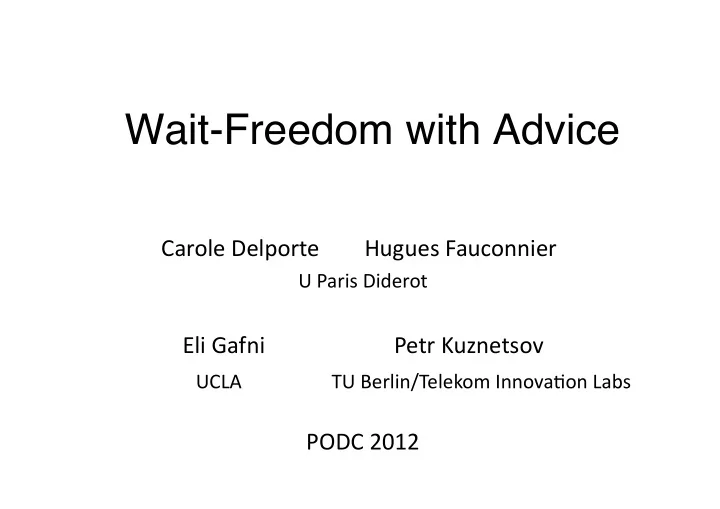

Wait-Freedom with Advice Carole Delporte Hugues Fauconnier U Paris Diderot Eli Gafni Petr Kuznetsov UCLA TU Berlin/Telekom InnovaDon Labs PODC 2012
Solving a task: correctness 2
Distributed tasks (I,O, Δ ) • I – set of input vectors • O – set of output vectors • Task specificaDon Δ: I →2 O k‐set agreement: • Processes start with inputs in V (|V|>k) • The set of outputs is a subset of inputs of size at most k • k=1: consensus • Colorless: allows for adopDng inputs or outputs 3
Solving a task: progress Every process outputs Unrealistic for systems with failures or very long delays Every process taking enough steps outputs (wait-freedom) Individual progress is a liveness property: a slow process may wake up and make progress later No notion of failures 4
But… Very few tasks are wait-free solvable Most can only be solved detecting failures Set agreement, renaming, symmetry breaking Failure detectors: private oracles that give hints about failures Bob is not coming back � Bob is still here � Bob ʼ s FD module is private! 5
Weakest failure detectors D is the weakest failure detector for a task T if Sufficient: D solves T Necessary: any D ʼ that solves T implements D (provides at least as much information about failures as D does) consensus: Ω (the leader FD) [CHT96] set agreement: anti- Ω [Zie07] k-set agreement: anti- Ω k [GK09] 6
Progress with failure detectors Assuming that every correct process takes enough steps Every correct process outputs Individual progress depends on other processes But can we solve a “hard” task wait-free? External oracle: wait-freedom with advice 7
External oracles External oracle 8
External failure detection C-processes (computation) S-processes (synchronization) 9
Wait-freedom with advice Assuming that every correct synchronization process takes enough steps Each computation process taking enough steps outputs Wait-freedom for C-processes … 10
EFD vs. FD Conventional (FD) model is a special case of EFD In EFD, the weakest failure detector for T is at least as strong 11
Special case: colorless tasks EFD and FD are equivalent w.r.t. colorless tasks: D solves a colorless T iff it solves T in EFD Weakest FDs for T are the same in the two models What about generic (colored) tasks? 12
A task characterization: k-concurrency Every task T is characterized by its concurrency level: The largest k such that T can be solved k- concurrently (assuming at most k participants run concurrently) k ≥ 1 (every task is solvable 1-concurrently) n-concurrent solvability = wait-freedom k-set agreement has concurrency level k 13
A task characterization k-concurrency can be simulated with anti- Ω k A k-concurrently solvable task is solvable with anti- Ω k (in EFD) [GG11,this paper] Each task is equivalent to some form of set agreement: The WFD for every task of concurrency level k is anti- Ω k 14
A hierarchy of n-process tasks concurrency level universal tasks ‐ Ω 1 Consensus . . . The easiest k‐concurrent k k‐set agreement . tasks anD‐Ω k . . The easiest unsolvable n‐1 (n‐1)‐set agreement tasks ‐ anD‐Ω Trivial tasks ‐ no FD needed n n‐set agreement 15
Implication: renaming (j,m)-renaming: j participants coming out with names in {1,…,m} In the conventional FD model, the problem is a FD (j,j+k-1)-renaming: k-concurrently solvable A variation of wait-free solution of (j,2j-1)- renaming [Attyia et al,1990] Concurrency lower bound is k What about (k+1)-concurrency? 16
Strong renaming (k=1) (j,j)-renaming: Strong j-renaming has concurrency level 1 By reduction to 2-process consensus [EBG09] The WFD for strong j-renaming is Ω universal tasks ‐ Ω 1 Consensus, strong j‐renaming 17
Weak j-renaming (k=j-1) (j,2j-2)-renaming: When j is prime power: concurrency level j-1 (j,2j-2)-renaming impossible wait-free (j-concurrently) [CR, 2010] The WFD for (j,2j-1)-renaming is anti- Ω j-1 The easiest (j‐1)‐concurrent j‐1 (j‐1)‐set agreement, weak j‐renaming tasks: anD‐Ω j‐1 When j is not prime power: (j,2j-2)-renaming solvable wait- free [CR, 2011], and thus with anti- Ω j : concurrency level j Can we solve (j,2j-3)-renaming with anti- Ω j ? Concurrency level of (j,m)-renaming? 18
Outcomes New EFD framework, separating computation from synchronization New understanding of what does it mean to solve a task (with a FD) Complete characterization of all n-process tasks, based on their concurrency levels 1,…,n Including colored ones, like renaming or k-set agreement among a subset of k+1 processes 19
“ Problems cannot be solved by the same level of thinking that created them ” THANK YOU! 20
EFD vs. FD Conventional (FD) model is a special case of EFD Bijection between C-processes and S-processes A C-process fails iff its S-process counterpart does In EFD, the weakest failure detector is at least as strong Should let a C-process decide even if its S- counterpart has failed 21
Simulations t-resilience ≅ t+1-process wait-freedom [BG93,Gaf09] Synchronous set agreement time lower bound [Gaf98,GGP05] k-concurrency ≅ k-set consensus [GG10] Adversaries, disagreement power [DFGT10,GK10] But these simulations are asynchronous, what if failure detectors are used? 22
A puzzle Solving consensus among every pair of processes (with a FD) is as hard as solving consensus among all [Delporte et al., JACM 2010] What about k-set agreement? In EFD: If D solves k-set agreement among some set U of k +1 C-processes, then D solves k-set agreement among all C-processes (simple simulation of processes in U) 23
Recommend
More recommend